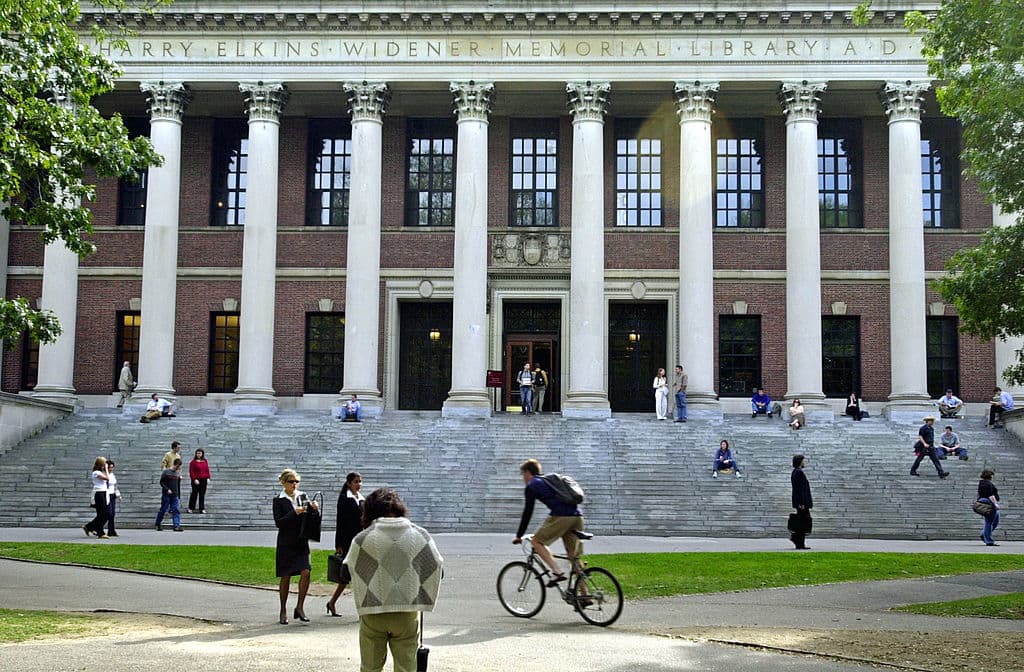Congress Probes ‘Enormous Decline’ in Jewish Students on Campus as Harvard Faces New Lawsuit
Inquiries into the changing landscape of Harvard’s student body in recent years bring to mind the oft-forgotten history of Jewish quotas at Ivy League universities.

As lawsuits and congressional inquiries mount against Harvard, some are left wondering whether the decline in Jewish enrollments at Ivy League universities might be playing a role in the rise of antisemitism on those campuses.
A group of Jewish Harvard students is suing the president and fellows of Harvard for “rampant anti-Jewish hatred and harassment” in an “egregious violation” of civil rights protections. Their demands, outlined in a complaint filed in a federal court in Massachusetts on Wednesday, include that the school fire faculty and discipline students engaging in such behavior and pay damages for diminishing the educational experience.
As bias against Jewish students at Harvard has grown, their representation at the school has thinned. The students suing Harvard estimate that there has been a 60 percent drop in the population of Jewish students in the last 10 years. They call it “an enormous decline that evinces an intentional effort, much like Harvard’s quotas one hundred years ago, to exclude Jews.”
The question of biased admissions standards was at the heart of the Supreme Court ruling against affirmative action in July. Congress is investigating the issue, too. The chairwoman of the House Committee on Education and the Workforce, Virginia Foxx, is demanding that Harvard provide data on the “recruitment, admission, enrollment, and retention of Jewish students.” Her committee is ramping up its scrutiny of universities allegedly harboring antisemitism.
“One cannot begin to grapple with the question of antisemitism without simultaneously understanding that the Jewish population has been at least halved but likely declined by over 60 percent over the last 20 years,” the executive director at Penn Hillel, Gabe Greenberg, tells the Sun. Ms. Foxx’s letter states that Harvard’s Jewish undergraduate population dropped to 9.8 percent of the undergraduate student body in 2023 from 25 percent in 2013, or to 700 students from 1,675.
Those numbers are still far higher than the 2 percent of the American population that is Jewish, but nevertheless they bring to mind the troubled history of Jewish enrollment at Ivy League schools. Harvard’s 22nd president, Abbott Lawrence Lowell, recruited students from regions of the country with smaller Jewish populations and introduced new admissions criteria, including personal interviews and submitted photographs, to cut the number of Harvard’s Jewish admits in the early 20th century.
Fifteen percent of the student body was Lowell’s ideal ratio of Jewish students, a number that he argued would eliminate the “race feeling” on campus. “If [the] number [of Jews] should become 40 percent of the student body,” he argued in a 1922 letter, “the race feeling would become intense.”
The issue was by no means unique to Harvard. A groundbreaking Stanford investigation in January 2022 unveiled biased policies toward Jewish applicants and students in the 1950s. “To disregard our stated policy of paying no attention to the race or religion of applicants,” the assistant to the president, Fred Glover, wrote in a 1953 memo, “was a matter requiring the utmost discretion.”
Amid the currents of the civil rights movement, the numbers of Jewish enrollments rose in 1967 to between 20 percent and 25 percent at Harvard, Yale, and Cornell, and roughly 40 percent at Columbia and the University of Pennsylvania, according to a New York Times survey that year. The Jewish Telegraphic Agency headlined its article, “Doors of Ivy League Colleges Reported Wide Open for Jewish Students.”
Penn, in particular, became “the jewel of observant Jewish life within higher education,” Mr. Greenberg tells the Sun. The university abandoned quotas that schools like Stanford retained for longer during the second half of the 20th century.
That downward trend, beginning between 20 years and 30 years ago, is “coinciding with Penn’s explicitly stated goals of diversifying the student body,” Mr. Greenberg says. While lauding this vision of diversity, he notes that the university’s thin commitment to students’ religious practices “makes life more difficult for the observant population at Penn.”
Now, Penn Hillel’s dining hall is just a campus dining hall. Many non-Jewish clubs and academic classes use its building. The school’s kosher dining hall is now open only five days a week, down from six days. These facts of campus life are creating a “self-fulfilling cycle,” Mr. Greenberg says, where people in the Jewish community are less likely to apply to Penn in the first place.
The data on college students’ religion are incomplete, the director of the Jewish studies center at Brandeis University, Leonard Saxe, tells the Sun. On campus surveys, Jewish students might not cite their religion as Judaism. Most universities do not ask for applicants’ religion, and neither does the U.S. Census. The House’s ongoing investigation seeks to obtain this information.
The director of open learning at American Jewish University, Mark Oppenheimer, is skeptical of Ms. Foxx’s request for more data. “Is Congress asking Harvard to go through their directories and guess by last name who is Jewish? It’s a pretty offensive idea,” he tells the Sun. Rebutting accusations of antisemitic ambitions at Harvard, he says, “there’s no evidence of anti-Jewish bigotry in admission offices in the last half-century.”
The overall trend, though, is hard to dispute. “The quest for both racial diversity and international diversity,” Mr. Oppenheimer says, “has certainly squeezed out some Jewish applicants, who are perceived (rightly or wrongly) as white, and who tend to come from the U.S. and Canada.”
Jewish students are also going to a wider array of campuses due to “the availability of lots of choices to Jewish students that weren’t available to them before,” Mr. Saxe says. While Ivy League schools have pushed for diverse admissions, large state universities with honors programs and private universities in the South, like Emory and Vanderbilt, are actively recruiting Jewish students. The Jewish undergraduate population at Duke, for example, has grown from 10 percent to 12 percent in the last five years.
“One way that we are going to deal with this new reality,” Mr. Greenberg says, “is to try to use the challenge as an opportunity and embrace and expand our mission to support and engage with non-Jewish students in robust ways,” like bringing non-Jewish students on trips to Israel.
At a moment when universities are donating millions of dollars to task forces investigating past exclusionary practices toward certain minorities, little attention is paid to historical attempts to limit the number of Jewish students. Harvard mentioned the word “Jewish” only once in its 2022 report on “Harvard and Legacy of Slavery,” a 134-page study of the school’s ties to 17th- and 18th-century American slavery.
A rare moment of such a reckoning came from Stanford’s former president, Marc Tessier-Lavigne, who apologized to the school community in 2022 for Stanford’s efforts “to suppress the admission of Jewish students in the 1950s and for the university’s denials of those actions in the period that followed.”

